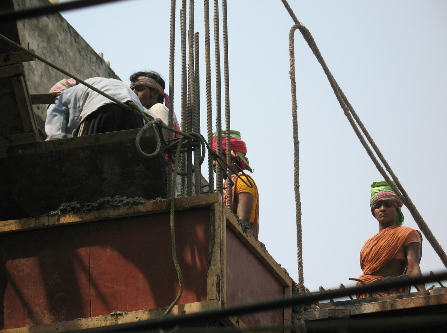|
Promoting Inclusive Labour Growth In India
As per the Employment and Unemployment Survey (EUS) of National Sample Survey Office (NSSO), in 2011–12, the average wage in India was about 247 rupees (INR) per day, and the average wage of casual workers was an estimated INR 143 per day. Only a limited number of regular/salaried workers, mostly in the urban areas, and the highly-skilled professionals earned higher average wages. While India’s economy in the past two decades has seen an annual average GDP rate of 7% – low pay and inequality persist according to the India Wage Report: Wage policies for decent work and inclusive growth, published by the International Labour Organization. The NSSO estimates also indicate that the real average daily wage has doubled between 1993–94 and 2011–12. Wages have seen a faster growth for the most vulnerable categories including workers in rural areas, informal employment, casual workers, female workers and low-paid occupations. Nevertheless, there remain huge disparities.
Casual rural female worker earns the least, pervasive inequality
India’s economic growth has resulted in fall in poverty, moderate change in employment patterns with a growing proportion of workers in services and industry. However, a substantial proportion of workers (47%), continue to be employed in the agricultural sector. The economy still faces informality and segmentation. More than 51% of the total employed in India, as per 2011–12 data, were self-employed and 62% of wage earners are employed as casual workers. While the organized sector has seen a rise in employment, many jobs in this sector too have been of casual or informal nature.
Though the overall wage inequality in India has declined somewhat since 2004–05, it continues to remain high. The decline in overall wage inequality has been largely due to the doubling of the wages of casual workers between 1993–94 and 2011–12. Nonetheless, the sharp increase in wage inequality for regular workers between 1993–94 and 2004–05 has stabilized in 2011–12.
The gender wage gap however is still steep, as per international standards, despite having declined from 48% in 1993-94 to 34% in 2011–12. The wage gap exists for all kind of workers – regular and casual, urban and rural. The women employed as casual workers in the rural economy earn the lowest in India, which is 22% of what urban regular male workers earn.
Although, the average labour productivity (as measured by the GDP per worker has increased), the labour share, which is the proportion of national income that goes into labour compensation has declined from 38.5% in 1981 to 35.4% in 2013.
Wage policies for decent work and inclusive growth
Though India was one of the first countries to introduce minimum wages through the Minimum Wages Act in 1948, there exist challenges in providing a universal wage floor for all workers. The minimum wage system in India is quite complex. The minimum wages are set by state governments for employees in selected ‘scheduled’ employment and this has led to 1709 different rates across the country. As the coverage is not complete these rates are applicable for an estimated of 66 % of wage workers.
A national minimum wage floor was introduced in the 1990s which has progressively increased to INR 176 per day in 2017 but this wage floor is not legally binding, in spite of a recurrent discussion since the 1970s. In 2009–10, nearly 15% of salaried workers and 41% of casual workers earned less than this indicative national minimum wage. About 62 million workers are still paid less than the indicative national minimum wage with the rate of low pay being higher for women than for men.
The report calls for several recommendations to improve the current minimum wage system. Some of these are – extending legal coverage to all workers in an employment relationship, ensuring full consultation with social partners on minimum wage systems, undertaking regular evidence-based adjustments, progressively consolidating and simplifying minimum wage structures, and taking stronger measures to ensure a more effective application of minimum wage law. It also calls for collection of statistical data on a timely and regular basis.
The report also recommends other complementary actions to comprehensively address how to achieve decent work and inclusive growth. These include, fostering accumulation of skills to boost labour productivity and growth for sustainable enterprises, promoting equal pay for work of equal value, formalizing the informal economy and strengthening social protection for workers.
|



